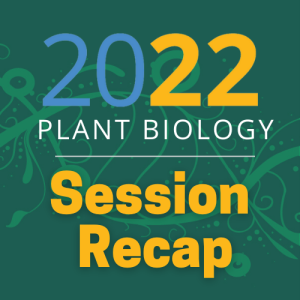By Stefanie Wege
 Crop Harvest on the International Space Station
Crop Harvest on the International Space Station
“Space research breeds on earth innovation,” stated NASA researcher Dr. Howard Levin during his presentation “Current Capabilities for growing Plants in Space,” the first talk in the concurrent symposium “Plants for Space,” which took place Sunday, July 10, 2022 at Plant Biology 2022. Dr. Levin introduced the different plant growth options already successfully used on the International Space Station, which rely heavily on hydroponic growth methods. He also highlighted the positive effects of growing crops, caring for living plants, and harvesting self-grown crops on astronauts’ mental health , and shared a striking image of space-grown, bright red bell peppers.
Growing Arabadopsis in Lunar Regolith
In addition to growth methods based on hydroponics, the potential to grow plants on substrates found on the surfaces of other planets and moons was evaluated, such as lunar regolith, the substrate on the surface of our moon. Prof. Anna-Lisa Paul from the University of Florida gave the fascinating talk “Plants Grown in Apollo Lunar Regolith Present Stress-Associated Transcriptomes That Inform Prospects for Lunar Exploration.” She and her research team planted Arabidopsis seeds in lunar regolith and, astonishingly, all of the plants germinated! Prof. Paul then showed that despite the absence of salt (NaCl) in the lunar regolith, stress responses connected to high salinity were transcriptionally upregulated. It seems that plants utilize salinity tolerance mechanisms to survive in the unusual growth substrate, suggesting that research in this direction might be key for gowning plants at a lunar base.
Root Growth in Space
Comparing the “flight crew vs. the ground crew” (i.e., plants grown on Earth vs. plants grown in space), Dr. Richard Barker from the Gilroy Lab at the University of Wisconsin – Madison presented an “Analysis of WT and Ca2+ Transporter Mutants Grown on the International Space Station.” Water movement in micro gravity differs significantly to that on Earth and can restrict root access to oxygen. He found that plant roots of the “flight crew” experience acidosis, and that modulating specific genes might help to improve root growth in space.
Addressing the Challenge of Nutrients for Plants in Space
Graduate student Noah Langenfeld from the Utah State University explained the challenge of supplying plants with nutrients. Transporting fertilizer to space is energetically and financially expensive and alternatives are required for sustainable space plant growth. In his talk “Nitrogen Recycling for Plants in Closed Life Support Systems,” Langenfeld presented his two research projects with the first on culturing N-fixing bacteria to replace the Haber-Bosch process. Currently, similar amounts of energy are required for both strategies, yet further research might improve the bacterial N-fixation approach and help guarantee the supply of nitrogen fertilizer to extraterritorial crops. The second project revealed the very promising finding that leafy crop plants such as lettuce can be grown on urea as their only N source without any growth penalty, paving the way for a closed extra-terrestrial life support system.
The Perfect Space Plant
During the last talk of the symposium, Prof. Alex Harkess from Auburn University and the Hudson Alpha Institute for Biotechnology introduced “Duckweeds and the Future of Food, Fuel, and Bioproducts in Space.” He explained that duckweed is the perfect space plant: it is edible, has a high protein content (similar to soybean), is among the fastest growing plants, and is multi-purpose. In addition to food, duckweed can, for example, also be used to produce medical biomolecules such as mRNA vaccines. Prof. Harkess also shared his research on flavoring duckweed by infusing the growth media to improve the culinary experience for astronauts on long-term missions. (This audience member now impatiently awaits the arrival of the promised “Dorito Duckweed”!)
A big thank you to the five speakers and the two session chairs, Prof. Jenny Mortimer and Prof. Matt Gilliham (both University of Adelaide, Australia), who organized this exceptionally interesting symposium!


____________________________
Stefanie is a researcher at the Institute of Crop Science and Resource Conservation (INRES) at the University of Bonn, Germany, and an Assistant Features Editor for Plant Physiology. Her main research focus is endomembrane ion transport and how it is connected to plant abiotic stress tolerance mechanisms.
